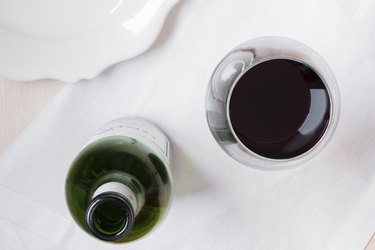
Wine is a popular alcoholic beverage that's made by fermentation of different varieties of red and white grapes, turning their sugars into alcohol. But, it's not all alcohol — a glass of wine also contains vitamins, minerals and antioxidants.
According to the National Institute on Alcohol Abuse and Alcoholism, a standard drink of wine is five ounces and has an alcohol content of 12%, or approximately 14 grams of alcohol. So, an eight-ounce glass of wine will contain roughly 19.2%, or 22.4 grams worth, of alcohol. As per the 2015-2020 Edition of the Dietary Guidelines for Americans, alcohol should be consumed in moderation, with the recommendation of one drink per day for women and up to two drinks a day for men.
Video of the Day
Video of the Day
Nutrition Information of Red Wine
The National Institute on Alcohol Abuse and Alcoholism's alcohol calorie counter estimates that there are 200 calories in a glass of Cabernet, or any other eight-ounce glass of full-bodied red wine. Sweet red wines like port wine contain 90 calories per two-ounce serving. Calories in 8 oz red wine may very based on the sweetness of the wine.
There are approximately 6.4 grams of carbs in red wine as well as 1.6 grams of sugar per eight-ounce serving. Red wine also contains minerals like calcium, iron, sodium and magnesium, with the highest amount of mineral being potassium. An eight-ounce serving of red wine contains about 298.4 milligrams or eight percent of the recommended daily dose of potassium, which the American Heart Association considers beneficial for regulating high blood pressure.
Red wine also contains trace amounts of vitamins like choline, which are required to maintain the structure of cells and the body's nervous system. Additional compounds include niacin, a B-vitamin required by the body for most cellular and metabolic processes.
Nutrition Information of White Wine
There are 193.6 calories in an eight-ounce glass of white wine, which is slightly lower than the calories in 8 oz red wine glasses. A two-ounce serving of sherry contains 75 calories. Dry white wines like champagne tend to be lower in calorie count, with an eight-ounce serving containing about 168 calories, which is lower than the calories in a glass of cabernet.
Just like the carbs in red wine, there are 6.4 grams of carbohydrates in an eight-ounce glass of white wine. The sugar content of white wine, however, is higher, at 2.4 grams. The sugar content is dependent on the type of white grape being used, along with geographical locations of growing — wines made from Riesling grapes typically tend to be sweeter.
White wine contains slightly more calcium per eight-ounce serving, when compared to red wine — 20.8 milligrams in a glass of white, compared to 19.2 milligrams in a glass of red. It also contains less potassium, with an eight-ounce serving providing some 167.2 milligram. White wine also contains trace amounts of vitamins like vitamin B9, choline and even vitamin K, which helps in bone health and blood coagulation.
Red Wine vs. White Wine
Studies have shown that the chemical compounds — called polyphenols — present in red wine provide a myriad of benefits, including helping you lose weight, decreasing the rate of aging and even lowering the risk of heart disease. The authors of an October 2017 study in Circulation found that red wine consists of ten times the polyphenols found in white wine.
Polyphenols such as flavonoids have been shown to reduce levels of low-density lipoprotein (LDL) cholesterol, and to decrease the development of atherosclerosis, thereby decreasing the overall risk of cardiovascular issues. The main chemical compound involved is resveratrol, a non-flavonoid polyphenol that's present in the skin of red grapes and known for its antioxidant properties.
Read More: Blood Type O and Wine
Resveratrol naturally occurs in many plant-based foods like blueberries, cranberries, apples and onions. In grapes, however, this chemical compound is present in the skin, with red wines averaging 1.7 to 1.9 milligrams of trans-resveratrol per liter of alcohol, based on the results of a July 2016 study in Advances in Nutrition.
Since red wine is made from red grapes varieties that keep their skin on during fermentation, the nutritional benefits of red wine — apart from the carbs in red wine and white wine which, at 6.4 grams, is the same — outweigh those of either white or rosé.
- Advances in Nutrition: "Resveratrol: How Much Wine Do You Have to Drink to Stay Healthy?"
- National Institute on Alcohol Abuse and Alcoholism: "What Is A Standard Drink?"
- National Institute on Alcohol Abuse and Alcoholism: "Alcohol Calorie Calculator"
- Office of Disease Prevention and Health Promotion: "2015-2020 Edition of the Dietary Guidelines for Americans"
- Circulation: "Wine and Cardiovascular Health"
- USDA: "Nutrition Facts for Red Wine"
- American Heart Association: "How Potassium Can Help Control High Blood Pressure"
- Office of Dietary Supplements: "Choline"
- Office of Dietary Supplements: "Niacin"
- USDA: "Nutrition Facts for White Wine"